L.A. Excursion
Before Thanksgiving, we had a short excursion to L.A. We stopped at Bakersfield for the night and came back by 101 the next day. Driving in fog at night was no fun. Luckily, we only got some fog around Bakersfield this time.
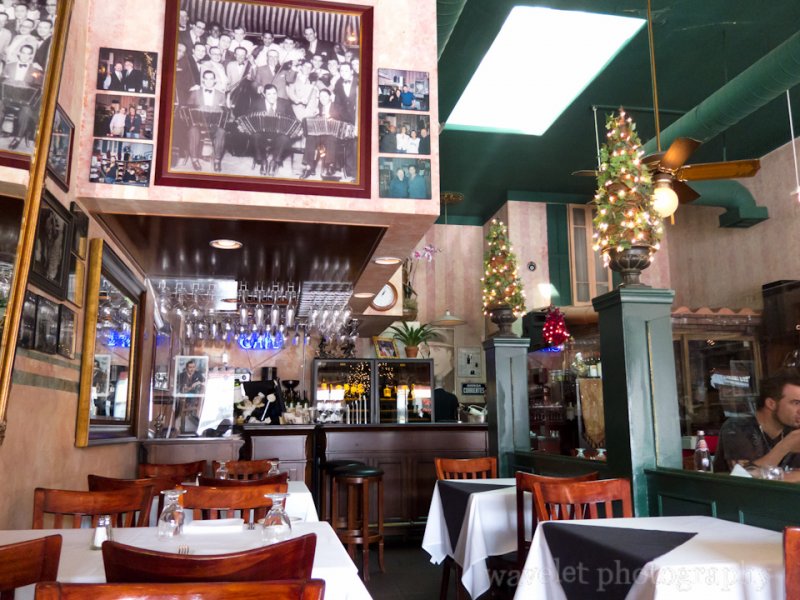
Before Thanksgiving, we had a short excursion to L.A. We stopped at Bakersfield for the night and came back by 101 the next day. Driving in fog at night was no fun. Luckily, we only got some fog around Bakersfield this time.

2011.7.10We got up early and took the boat back to Puerto Maldonado to catch our flight to Juliaca via Cusco. After the boat was docked, we were transferred to Inotawa’s car. Before we could leave, we had to go to the town center to get some cash – we had not paid our trip yet because we couldn’t make money transfer in Lima during weekend. We were in a bit of hurry, but as luck had it, not far from the port, when the car were climbing a slope, the engine stopped working. Luckily, we found another tour group that was going to the town as well. They dropped us near the town center. Our guide called a motocarro. It is the most popular transportation in the city. Riding one is a travel experience, but we couldn’t think of that at the time. ATM machine could be found at one side of the main plaza. There seemed to be a martial festival and soldiers in different uniforms marched around the plaza – I didn’t feel like taking picture either.
In fact, we still had 40 minutes when we got to the airport. We got both flight confirmed and seats assigned. After half an hour, we arrived Cusco without any delay. But while we were waiting for the transit flight to Juliaca, as boarding time approaching, we realized the gate was actually for a flight to Lima. Checking with LAN’s personnel, we learnt our flight had been cancelled. There was a strike in Juliaca and some part of airport facility had been damaged. The planes were only allowed to come in and out Juliaca in the morning. We were so surprised because no one informed us earlier. At Puerto Maldonado, LAN’s counter must have known the connection flight wouldn’t exist. We considered to take bus to Juliaca because we really didn’t want to miss the Lake Titicaca tour the next day, but thinking of that we could be grounded in Juliaca and missed our international flight back home, we decided to spend another day at Cusco.
We went back to El Dorado San Augustin Hotel. One restaurant I noted before the trip was closed for renovation. To make sure not to make mistakes on selecting restaurants, we went to Chicha again for dinner.
After dinner, I had the opportunity to take some night shots around Plaza de Armas. Temperature drops fast after sunset at this altitude. In July, it is barely above freezing point at night.
Missing the Lake Titicaca trip allowed us to explore more in Cusco, which we didn’t have enough time before we went to the jungle. In the next morning, we first walked to the Church of San Cristobal. It’s built on the hill of Colcampata, about half way to Sacsayhuamán. The church has a modest design but offers a wonderful location to overlook the city. The stone-paved narrow alleys leading to the church, presenting various vivid colors in doors, balconies and tiles, were fascinating too.
Plaza Regocijo is next to the Plaza de Armas. The hotels, restaurants and cafes around the plaza have a modern touch compared with other places in the city. We had some snacks in a cafe and had our final lunch at Inka Grill.
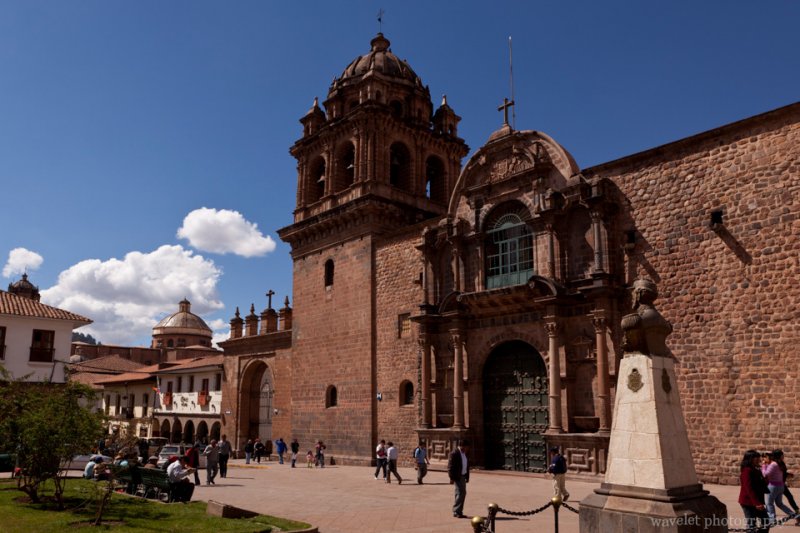
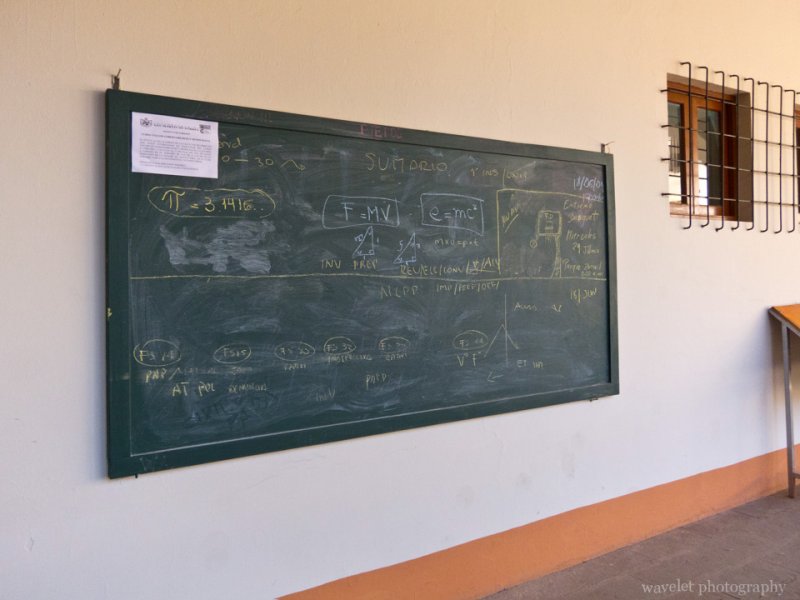
We left Cusco in the afternoon. Coincidently, during our 7-hours wait at Lima airport, we met those two Americans who shared the boat with us on Tres Chimbadas Lake in Amazon. They went to Lake Titicaca earlier without even aware there was a strike, because their flights were all in the morning. They comforted us by saying that it’s the least favorable place in their trip because it’s too commercialized.
We didn’t plan to go to Nazca Line or the Northern Peru because they are too out of the way, but the places we visited were culture-rich and diversified enough to keep us dream on for the next trip in the future.
2011.7.9Clay-eating behavior by macaws is unique in western Amazon region. Traditionally, it is believed that macaw’s diet contains toxic elements so they eat clay from exposed river banks to neutralize the toxins; but new research showed that macaws prefer clay with higher levels of sodium, which indicate the reason of clay lick is to obtain this vital element that is scarce in environments far from the sea.
We got up at 4:30 in the morning. Wind knocked the dew off leaves and it sounded like rain. It’s our biggest concern because Macaws wouldn’t come if it’s raining. After a little breakfast, we set off at 5:00am. For 5-minute boat ride, we arrived at the spot. The river makes a big detour here. The water level is low, the land in the middle is like an island and the river bank is like a cliff in 180 degree arc-shape. There are enough space for Macaws to lick.
Around 5:30am, parrots started coming in large groups. Soon the number reached several hundreds. They circled around the area and stood on the tree branch for no more than15 minutes, several at first, then suddenly all of them came down from the tree at the same time and started licking. Our guide showed us a brochure called “Tambopata Field Guide of Parrots”, which illustrates about 20 species of Macaws and Parrots. Most parrots we saw on the cliff were of blue feather on their head, they might be Blue-Headed Parrot. The rest were in total green, I don’t know what they are.
Macaws usually came as families, either a pair or a parents with their chick. Compared with their hasty relatives, macaws were more prudent. They stood on top of the trees and watching parrots busy licking disdainfully. In 10 minutes, in the same manner as they came down to the cliff, parrots left the river bank all together simultaneously. Lingering for another 5 minutes, they all disappeared.
Macaws are big birds and certainly took themselves more seriously, anything abnormal made them suspicious. We wanted to move closer to the river to see the birds more clearly, but the guide of another tour group told us that our cloth color was too bright, so we had to retreat further back and hid ourselves in the bush. This started our standoff with macaws for the next 3 hours. More macaws were coming. We saw all three kinds of large-size macaws in the reserve, Scarlet, Red-and-Green and Blue-and-Yellow Macaw. They were at least twenty macaws of each type. They gathered on their own trees and never mingled with others. Sometime, they seemed feeling safe and gradually moved to lower branches – macaws never go to the river bank directly, they always do it step by step – but all of sudden, maybe because they heard something or saw something, they flew back to the top of the trees again. Sometimes, they just moved to another tree 100 yards away.
The other group had left and we also went back to the boat to take a rest. We then decided to let the boat go back to the camping site to wrap up our staff and we stayed here and kept waiting. In the next hour or so, we sit among the bushes, put large leaves on our heads to cover us from the raising sun. For some reason, Blue-and-Yellow Macaws left one family after another, but Scarlet and Red-and-Green Macaws were still here.
The remaining macaws kept playing tricks with us. Finally at about 9:40am, one of Macaws came down to the cliff, then others followed in minutes. There were about twenty macaws on the cliff at the same time. This lasted less than 10 minutes. Our boat came back, the sound of motor broke the serenity. Macaws went back to the tree. The guide said it might take them an hour to come down again. From what I read before we left to Peru, beginning of July is not a good time to watch macaw’s clay click. At least we saw all of them and we waited long enough for them to be on the cliff. The only regret I had was that I should have taken more pictures.
The returning trip took only 3 hours. When we walked into the lodge, a group of American middle school students meeting at the open patio. They are the new guests of the lodge. We had the lunch of fishes that the captain caught in our trip.
At the afternoon we had our last activities of the Amazon trip – we went to Tres Chimbadas Lake to fish piranhas. It was only a short boat ride away downstream, after that we walked about one mile to across the jungle. Together with another guide and his tour group, we paddled around the lake watching birds at lake side. The lake was quite and water was dark, maybe because it doesn’t connect to the river. We docked our boat and tried to fish piranhas. Most popular piranhas are golden one in the lake. They don’t really eat human, but they were quite aggressive at the baits we threw in. One guy from another group caught one fish, I almost got one too but as I pulled the pole out of the water, the fish got loose and gone.
The night already fell as we left the lake. On our way back to the lodge, the guide used searchlight to scan the river shores looking for caimans. Caiman’s eyes reflect the light and will be seen as two red gleams. We didn’t have much luck and only saw a small caiman. I caught it on the video.
2011.7.8In the morning, I had a walk around the lodge and took some more pictures. Parrots sang and frogs croaked, I was immersed in the sounds of nature.
Our plan for the day was to take boat upstream for 4 hours to Chuncho. We would camp there over night and watch Macaw’s clay lick the next day morning. Most visitors to the lodge take 3 days and 2 nights tour, so they only go to see Macaws in a place near the lodge. We certainly wished that we could see more for the extra day and money we spent.
Unlike our White Desert trip in Egypt, which we went with only a driver and a guide, we had a large team of 5-person here, our guide, a captain (driver), his assistant, a cook and the lodge owner’s daughter-in-law. I guess visitors rarely take trips like this, so the owner’s daughter-in-law was interested in seeing those Macaws too.
After one hour, we arrived at the first check point of Tambopata National Reserve. We signed our names on their huge signature book and they stamped a puma mark on our passports.
The captain had sharp eyes. He often spotted something unusual on the bank and he stopped the boat and pointed them to us.
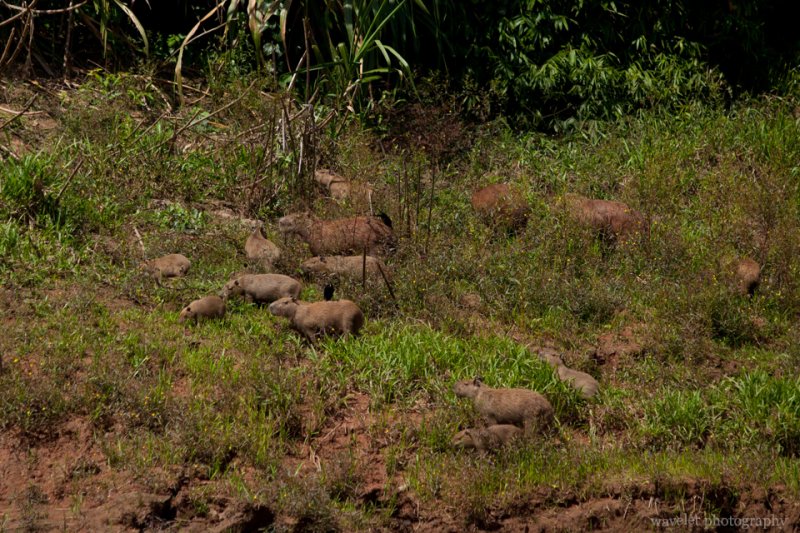
It was the dry season – sometimes the water level was too low and captain’s assistant had to use a long pole to move the boat.
He also had to watch the river for torrents and obstacles. The river was smooth most of the time, but it was turbulent with floating logs and underwater reefs at some places. I heard the assistant talked with our guide about one incident he had, although I don’t understand Spanish, but from their moves, I knew the assistant was saying that he was on a boat that hit the reefs, shot up and threw him into the water.
After another two and a half hours, we reached the second check point. The Tambopata River and the Malinowski River merged here. Their color difference is quite distinctive – the Tambopata River is clean and the Malinowski River is in brown color.
We kept on sailing upstream in Tambopata River. The water became clear and tranquil.
It took us some time to locate a small island to dock the boat. Our guide said, the last time he came here was several years ago, the water and land looked very different now. The river changes route every year. An experience driver is necessary to sail in the river like this.
While others were setting up camps, our guide took us to a short hike on the island. The island is covered by the secondary forest. The plant species is not very diversified.
We came back without walking very far. Four tents have been setup. The captain and his assistant would sleep on the boat. We had some free time playing around the island, while others swimming in the river and preparing the dinner. It was warm during the night and surprisingly there were not many mosquitoes. It was much more comfortable than we imagined.
2011.7.760% of Peru lies in the Amazon. Our next destination is Puerto Maldonado, a city located at the confluence of the Tambopata River and Madre de Dios River, which is a major tributary to the Amazon River. To see the real Amazon River, one has to go to Iquitos, several hours of flight from Lima. Puerto Maldonado is much more accessible from Cusco. It is only half an hour flight away. Shortly after taking off, the grand Andes gave its way to the endless green expanse. The border between the two areas was quite distinctive viewed from the plane. As we were close to Puerto Maldonado, the plane flew along Madre de Dios River, which was like a brown belt winding through the plain.
Elevation drops dramatically from Cusco at 11000 ft to Puerto Maldonado at 600 ft. The temperature was 90F. We arranged our tour with Inotawa Expedition that was recommended by a review I read online. In hindsight, I feel it is a tour company in the right size for us – they are big enough to have decent facilities, but not too big so we still have the feeling of experiencing something authentic. We were picked up at the airport together with a Swedish lady and three girls from South Africa. After briefly stopped at the office, also the owner’s house, 5 minutes from the airport for logistics, we took 20-minutes bumpy drive to a small port of the Tambopata River. From here, we took the boat for two hours to the lodge.
The Tambopata River flows 250 miles from the Andes into Madre de Dios River. At this section, it is wide, quite and slow. It is one of the most bio-diversified region in the world.
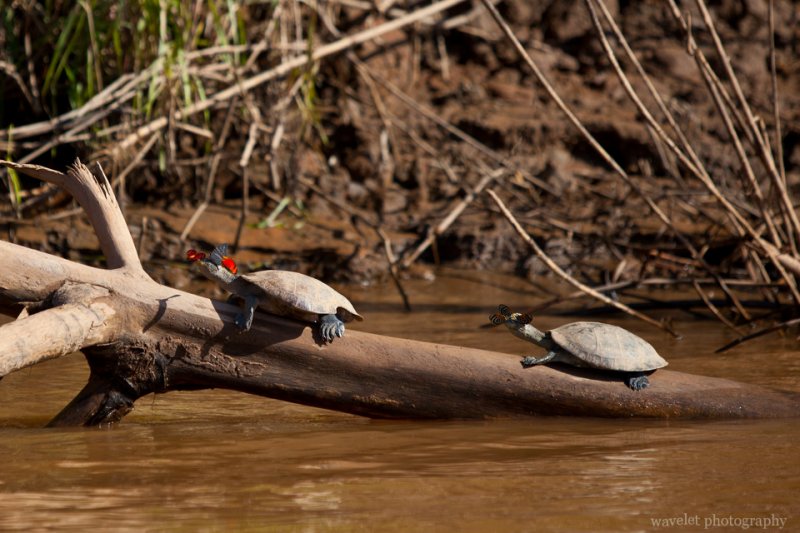
After the boat was docked, we climbed up some wooden stairs. A hike on a shaded trail for 5 minutes led us to the Inotawa Lodge. The lodge is built in the middle of the forest. In the front is a lobby-like open patio with several chairs and hammocks; after that is an array of shared rooms used to accommodate tour groups; then the corridor splits, one leads to the dining area and kitchen, the other leads to a garden and second living area that has several cabins including the one that we would live in.
Inotawa Lodge is an “eco lodge”. It has no fence and totally opens to the forest. We sometimes heard strange footsteps at night near our cabin. The bats and bees can get into the cabin from the open space between the screens and the roof. The room has no electricity and water is conducted from the water tank to each room through pipes, both made by bamboo. All of these made the experience more like an expedition than a vacation. It is what we came here for! The service was very good and they made delicious food too. We ate with our guide and other guests at the common dinning area every time when we were at the lodge.
There are several trails around Inotawa Lodge. After night fell, we had a walk in the jungle with our guide. We saw a lot of ants and spiders, in different size and color. The most exotic one was two huge tarantulas hiding in their nest in the ground. Other bugs we encountered including a centipede and a stick-insect, nothing dangerous or too surprising, but it’s an interesting experience.
Without lights and Internet, People in the jungle sleep early at night. The alleys in the lodge were marked by oil lamps made by cola bottles. The staff put them out at 9pm. I had a chance to take some shots of the southern hemisphere sky.
2011.7.6After Spanish conquered Inca empire, they stopped at Ollantaytambo without pursuing further deep into the Urubamba Valley. Machu Picchu survived the destruction from the Spanish, but it was also abandoned by Incas and left to nature to reclaim. Machu Picchu became a lost city and only existed in legends for hundreds of years. When Hiram Bingham reached Machu Picchu in 1911, although submerged by centuries of growth, the massive ruin was still well preserved. With the dominating Huayna Picchu forming the backdrop, the spectacular view of the ruin not only makes Machu Picchu one of the most recognizable landmark of South America but also ensured it a position of the New Seven Wonders of the World.
The train arrived at Aguas Calientes, a small town at the foot of Machu Picchu, at around 9pm. We met the person sent by the hotel at the train station and walked 5 minutes to the hotel. The hotel is so close to the train station that I could see our train leaving from the window. The hotel is called Machu Picchu Green Nature. The facility is at its very basic, but it’s tidy and clean enough. We would only stay there for a few hours.
To protect Machu Picchu’s cultural and natural environment, in 2005, Peru government set the maximum number of daily visitors at 2,500. This limit is not known to many people. In the last week of July this year, this limit was reached and visitors were turned away. What is more well-known is only 400 people are allowed to climb Huayna Picchu every day. The direct result of this regulation is that anyone who wants to stand on the top of the Young Peak, what Huayna Picchu means literally, has to get up very early to line up at the entrance of the citadel to get the permission.
Buses run every 10 minutes starting from 5:30am to take people to Machu Picchu. It’s the beginning of July, Machu Picchu’s peak season. We have learned that if we really wanted to be one of the first 400, we’d better be at the bus station before 4am. This made us struggled. We didn’t set an alarm, but at 3am I just woke up. I figured that I’d rather getting up to do it than lying on the bed to think about it, so I decided to go by myself and meet my wife later at the citadel. It was dark at the lobby, but the hotel had someone waiting there to open the door for those who were crazy enough like me. The nicest thing was, breakfast was prepared. I had several pieces of ham and fruits and took one banana with me. It’s 4am when I get to the bus station. It’s a queue there!
I was standing at the end and couldn’t see how long the queue was. Young people in groups passing us by from time to time – instead of taking bus, you can also walk the trail to Machu Picchu. The family who toured Sacred Valley with us the earlier day had warned us that “the trail is steep and no fun”, but I couldn’t stop thinking the possibility that the quota could be all used up by hikers, because I did see at least 30 people passing by in 5 minutes and the bus wouldn’t start in an hour. At last my anxiety took control so I left the queue and joined the hikers. We walked in the valley under stars for about 20 minutes, to my surprise, I saw another queue. The trail starts after crossing a bridge. The gate won’t open until 4:45am.
Everyone was excited when the gate was opened. People hailed and run through the bridge, but this cheer soon faded. All left were the sound of heavy breathing. Machu Picchu is at only 400m above Aguas Calientes, but the trail zigzagged almost directly up to the hill. The stairs seemed endless, and because it’s still dark you could see nothing except the persons in front of you. The worst of all, you don’t want to take to much rest because everyone passing you by could potentially pushing you out of 400-person quota. This is for sure one of the most demanding hikes I’ve ever made, (I am not a person who hikes often), I sware more than once that I would never do this again. At last, at the time when I had to stop every 5 minutes, I saw the light of the sky.
It’s about 5:50am. The queue was already quite long. They were earlier than me for three possible reasons, they hiked faster than me; they took the first one or two buses leaving the station; or they lived in Machu Picchu Sanctuary Lodge Hotel for $900+ per night. The hotel is only steps away from the entrance of Machu Picchu. It charges the premium not because of its facilities but for its optimal location. Even at this price, the rooms are always fully booked well ahead. Machu Picchu opens at 6am. I got my ticket stamped as No. 260. (There is a different line if you don’t plan to climb Huayna Picchu.)
I didn’t realize that I had to climb to the top of the terraces, the Hut, in order to get the classic postcard shot, instead, I settled at the middle. Finally, I saw Machu Picchu with my own eyes. It’s just like in the pictures – perfect! It’s not dark anymore, but the sun won’t break out from behind of the mountains until 7:20am. The best part of being early is you can enjoy the serenity of Machu Picchu devoid of the tour groups – they usually come after 10am. There were only a couple of hundred people in the site and they soon scattered into the ruin, some of them already started climbing Huayna Picchu as the first batch at 7am. After another 10 minutes or so, the sunshine gradually illuminated the tip of Huayna Picchu, Temple of the Sun and the bottom of the ruin. It is a soul-purifying experience.
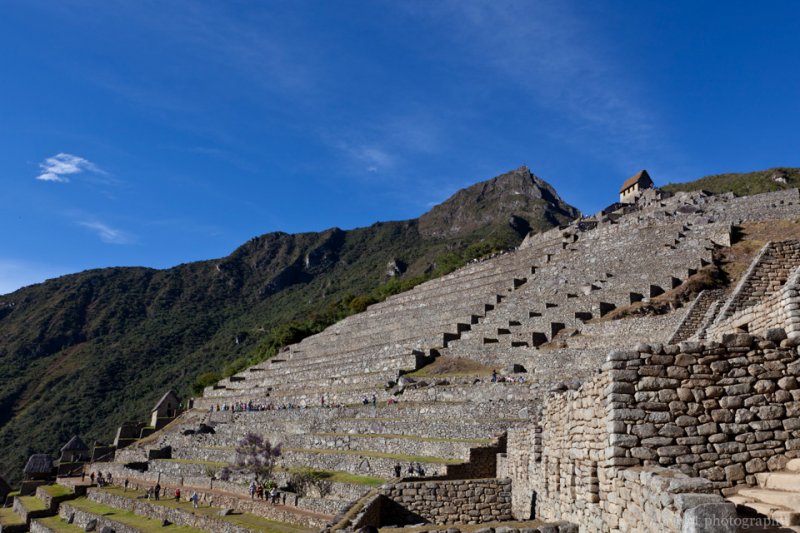
My wife and I reunited at 8am. We had two hours to walk around Machu Picchu.
When you get the ticket stamped you can choose when to start climbing Huayna Picchu, either at 7am or 10am. The reason I chose 10am was that early morning is the best time to see the ruin before crowds come. At 10am, I came to the trail head at the back of Machu Picchu. I have about two third bottle of water with me.
People waited at the trail head. You are asked to sign your name in before climbing.
The trail goes downward first. Huayna Picchu is also called Wayna Picchu. The smaller peak can also be climbed. I almost took the wrong trail at the fork.
Huayna Picchu is about 1100 ft (360m) higher than Machu Picchu. From here, it is all upwards.
The trail contains a lot of switchback. Most part was in the shade. Handrails are provided at steeper sections. It is not dangerous at all. I got tired soon because of the agonizing morning hike, but this time I could take as much rest as I wanted.
The very top of the peak is made by several boulders. There is a small opening in the middle so you can get to the summit.
The summit is just a few rocks, but for every square foot, there was someone standing there. You need to be very careful not to lose your feet when moving on these rocks. I believe it was a guide who stood in the center to coordinate visitors and sometimes took pictures for you.
The view was breathtaking, especially the mountains that drop vertically to the Urubamba River and the holistic view of Machu Picchu. The zigzag road is the bus route. The green-roofed construction at the road end is the Sanctuary Lodge. You can see a small trail between the bus route and the ruin. It might be the trail we hiked this morning.
The most difficult part were all at the beginning of the returning trail. It started with a steep slope that required some hands-feet crawling …
… followed by a flight of dangerous-looking steps …
… and another very narrow and steep stairs. Hold on tight to one side of the cliff and walk sideways.
After that, the steps merged back to the trail where I came from. Ascending took me a little more than 1 hour and it took me about same amount of time walking down. Overall, it was not a demanding trail, if I had taken the bus in the morning, climbing Huayna Picchu itself wouldn’t be very challenging; but now, when I signed out at the trail head, my legs were shaking. Walking on the flat land had never made me felt better.
My wife had been waiting for me at the Caretaker’s Hut. We took some rest and we left Machu Picchu. Sanctuary Lodge Hotel has the buffet lunch. At that time, no matter how much they charged, I would eat there – what I need the most was water. The buffet’s quality was good, the price was reason in American standard.
We took 3:20pm train to leave Aguas Calientes. What we took this time was the Vistadome train. Unlike what people in TripAdvisor said, the it didn’t have more window that the Expedition train we took the day before. It did offer a light dinner and run a fashion show – the crews wearing locally-made clothes and walking through the aisle. Sitting facing to us was an old American couple. The husband is a professor of Duke University. Very well traveled all over the world, they are very good talkers too. We not only shared a lot of travel experiences, but also found out many common traits in travel planning and preferences during the trip. We spent a nice four-hour and when we disembarked the train it’s already dark.
Poroy station is quite far from Cusco city. Once we checked into the hotel, we came out to find food to eat. I must say I earned some credit after picking Chicha the earlier night, so we went to try the restaurant that is rated No. 1 in TripAdvisor, Marcelo Batata. It was a total disappointment. It might be a fun place for groups, but the food was …, what can I say, Peruvianized American food. (I’d rather eat Americanized Peruvian dishes.)
2011.7.5Sacred Valley is a valley along the Urubamba River close to Cusco. It is generally considered to include the area between Pisac and Ollantaytambo. Its mild climate and fertile soil made it the key settlement area, the heartland, of Incas. Through the valley, Incas could access to the Amazon plains and trade agricultural products with jungle tribes. At the time when Spanish invaded the Empire, Incas retreated to the valley for protection.
Peru
Peru
Peru
Peru
Many tour companies at Cusco provide Sacred Valley one-day tour to stop at several Inca ruins and markets. We booked the group tour through Llama Path for $20 per person. At 8am, We were picked up in their office next to Plaza de Armas. Before we set off, several people in our minivan joined the Spanish speaking tour in a large tour bus, what left were just two of us plus another American family of 3 persons. It’s almost like a private tour for us.
Out of the Cusco city and passed several rural villages, our first stop was a small market. We bought a Peruvian hat and a pair of gloves. It turned out to be quite useful the next day while I was waiting for the sunrise at Machu Picchu.
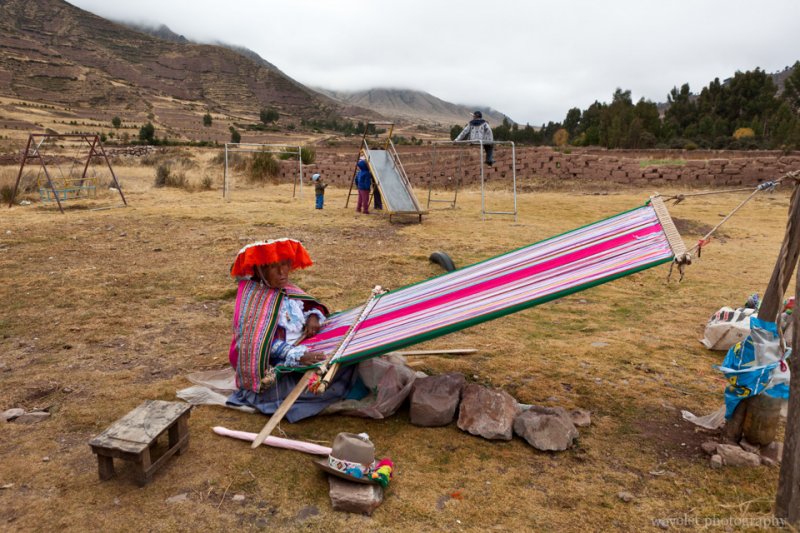
Before going to the tour, I had been thinking Sacred Valley as a place that you have to go but nothing exciting, however, when I saw the valley with my own eyes, I was truly impressed by the beautiful and majestic landscapes.
Písac is the first major ruin we visited during the tour. Renowned for its large scale terraces, Písac is commonly believed to be the southern gate of Sacred Valley; thousands of mummies have been found on the cliffs at the back of the ruin; and houses on top of the hill were used for rituals and storing crops – at the Inca time, Písac served at least agricultural, religious and military purposes.
The market in Písac village is another tourist attraction. Besides clothes, what is more interesting are the farmer’s market and art stands.
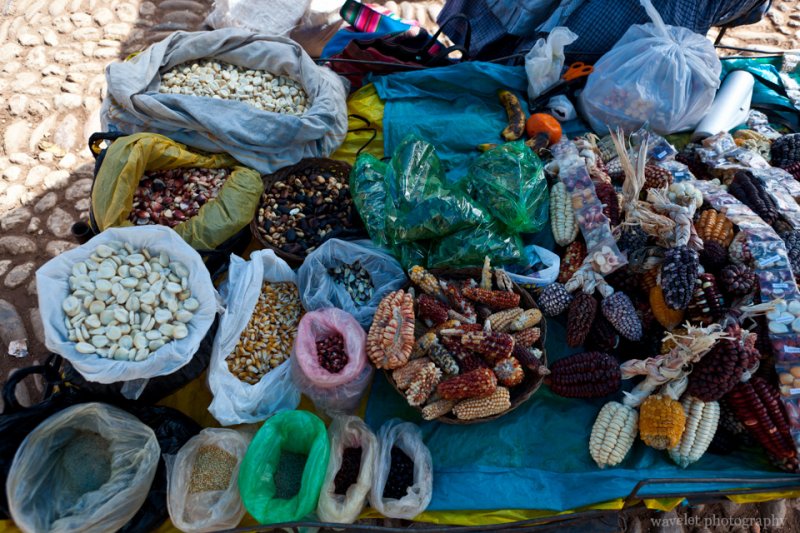
We stopped at a roadside restaurant, named Jacaranda, for lunch near Calca. The buffet was delicious for 20 sol per person and the garden was decent too.
As we went along the Urubamba River, the elevation kept decreasing. For about another hour, we arrived at Ollantaytambo, which is 2,000 feet (600m) lower than Cusco.
Ollantaytambo was built in 15th century by Inca emperor Pachacuti, who is considered as the most powerful Inca. Under his reign, the Empire’s territory was greatly expanded, several major sites, including Cusco, Sacsayhuamán and Ollantaytambo, were constructed and rebuilt. Ollantaytambo was not only a palace for Inca nobility, but also a fortress that protected the northern entrance of Sacred Valley. After Spanish took over Cusco, Ollantaytambo became the temporary capital of Inca resistance.
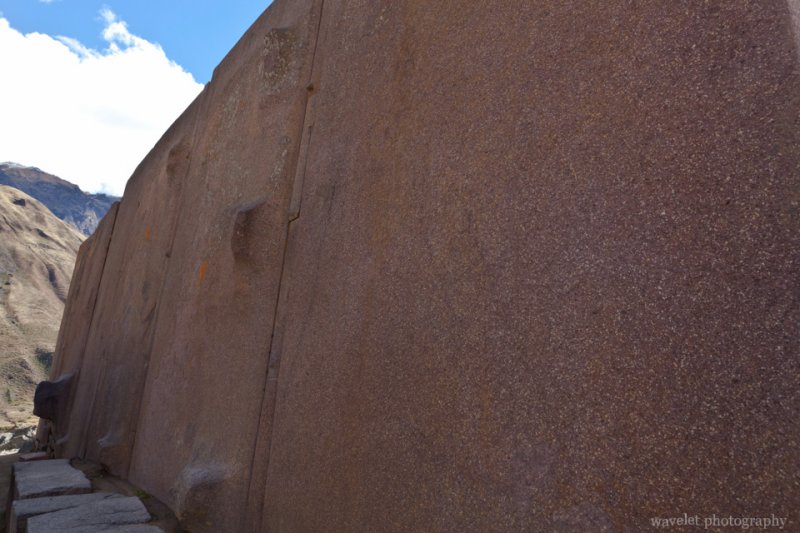
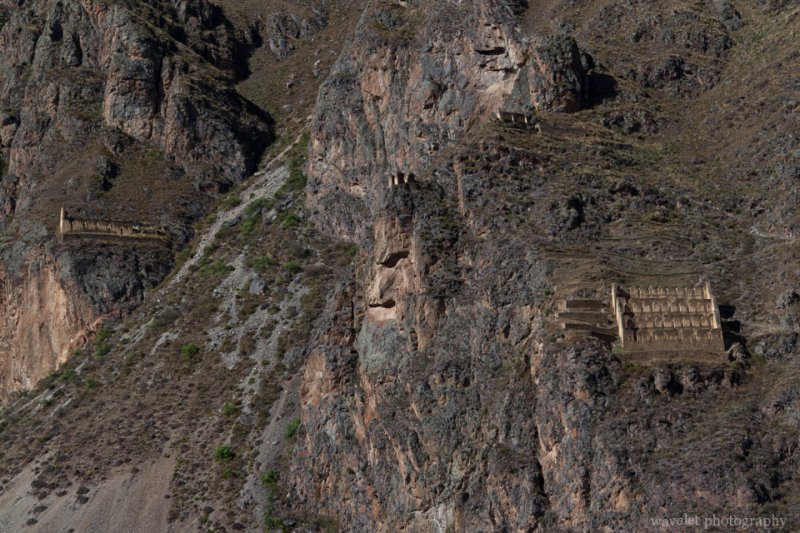
Incas developed extensive network of roads to connect the empire. The most famous one, Inca Trail, starts from Ollantaytambo. It takes 3 day and 4 nights hike to reach the lost city, Machu Picchu. Hiking the Inca Trail is considered to be one of the life-time achievements. As more tour companies offer the guide service, it is doable today for most of people. Our plan was to take Perurail’s train from here to Machu Picchu in 2 hours, so we had to skip the rest of Sacred Valley tour. Our train was at 7pm and now it was only 4pm. We started wandering around Ollantaytambo’s plaza and market.
It’s getting cold quickly when the Sun is getting low. We sit in a restaurant called Panaka Grill at the corner of the plaza and spent more than 2 hours there. Its ambiance is way better than other places but the food was too Americanized. Too much cheese on the Pizza.
It only took 15 minutes to walked to the train station. There were many people waiting at the gate already. We took the Expedition (Backpacker) Train, which is the cheapest option, to Machu Picchu. It was in fact very clean and comfortable. Water and snacks were also provided. I noticed Perurail let the local passengers in first to take other carriages. I guess it would be less nice but much cheaper.
2011.7.4Cusco is located at Andes mountain range at southern Peru. It was the capital city of ancient Inca Empire. Inca arose in the early 13th century. Within two hundred years, it had expanded its territory to the major portion of western South America and become the largest empire in pre-Columbian America. It is believed when Cusco was built in the 15th century, the city was planned in the shape of a puma. After Francisco Pizarro conquered Inca Empire in the 16th century, The Spanish destroyed most of Inca buildings and temples, replaced them with Catholic churches and buildings in Hispanic style.
We arrived at Cusco at morning from Lima. Maybe because we took the high altitude pills the previous day, we felt little about Cusco’s 11,200 ft (3,400 m) elevation. It was the only day we planned in Cusco, so we started walking around the city once we settled at El Dorado San Augustin Hotel.
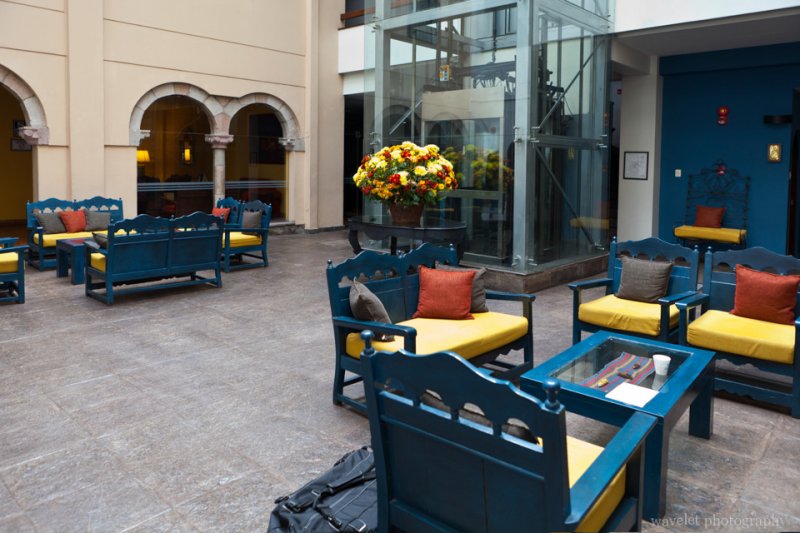
Cusco today is a tourist hub, visitors come here to visit Inca Heartland, such as the Sacred Valley and Machu Picchu, or route to Lake Titicaca and Amazon Jungles. Cusco is a lively city. Plaza de Armas are always filled with travelers and local people. Countless shops, restaurants, hostels and travel agents at the city center serve 1.5 million visitors every year. The churches and stone arches around the plaza are reflections of Spanish influence. Their graceful shapes, elaborate facade, colorful wooden balconies and red-tiled roof make Cusco a very picturesque city. The only complaint we have is its air pollution from old cars during the peak hour.
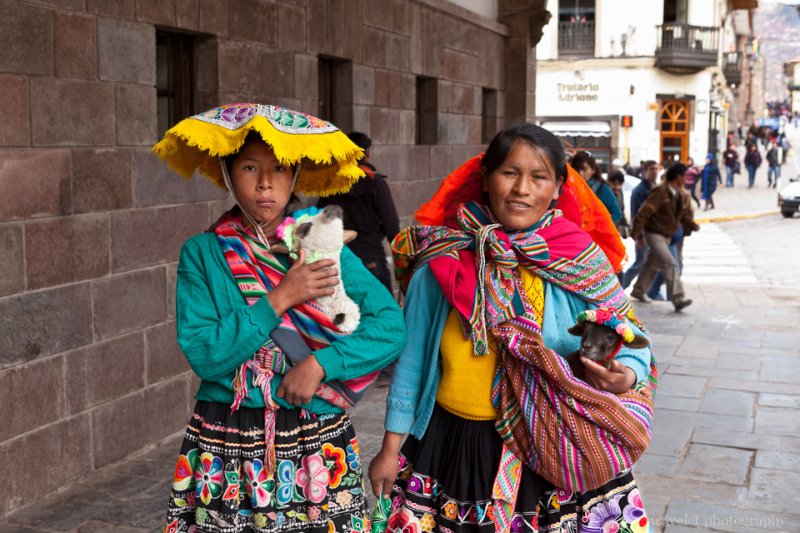
After having a quick lunch of pizza, we hailed a taxi to take us to Sacsayhuamán. Can be easily mispronounced as “sexy woman”, Sacsayhuamán is neither sexy nor feminine – it is an military fortress of Cusco city at Inca time. When designing Cusco in the shape of a puma, the Incas imagined Sacsayhuamán as the head and its walls in a zigzag fashion as the beast’s teeth, while the city was the body of the animal. The rampart has three-level foundations constructed by meticulously placed stone blocks, some weigh as much as 350 tonnes. From bottom to top, these three levels are identified by three sacred animals, snake, puma and condor. After the Spanish captured Cusco, many walls including three towers on top of the fortress were destroyed. Sacsayhuamán was used as a quarry and stones were taken to the city to build churches.
Besides its military purpose, the complex was used for religious rituals. This tradition continues today – as we visited Sacsayhuamán, it was preparing the event of celebrating the 100th anniversary of the discovery of Machu Picchu. There were not many tourists at Sacsayhuamán, but at the time we left, we saw several tour groups coming, maybe this is the last stop of the Cusco city tour. At the exit, there were a lot of opportunities that you could take pictures with local women and their Alpaca.
Coming back from Sacsayhuamán, we kept wandering around in Cusco before sunset.
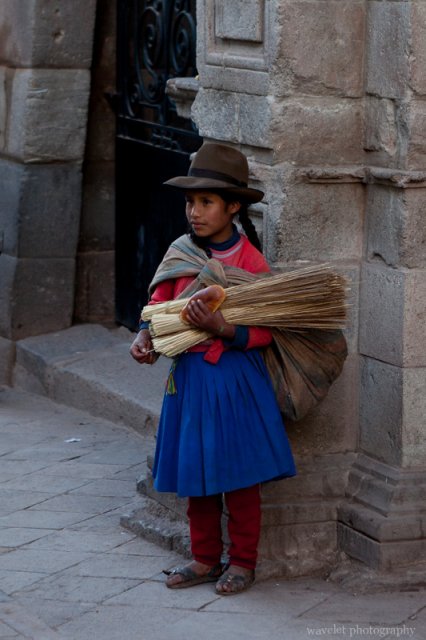
Because it’s the winter of southern hemisphere and Cusco is located within Tropic of Capricorn, it’s already dark at 6pm. Following TripAdvisor’s recommendations, we went to Chicha for our dinner. The word of “chicha” refers to a varieties of beverages in Latin America. The atmosphere was very nice, the food was very good too. I think they might be revised version of Peruvian dishes, but we fully enjoyed them.
2011.7.3Our flight is scheduled to arrive at midnight. Because of the delay, it was 2am when we got to Lima Airport. We arranged a taxi through the hotel beforehand. Although $38 charge is too much expensive, I believe 50 sol. should be more than enough to call a taxi at the airport, but because all the reviews we read told us that Lima is not very safe, we decided to stick with hotel’s arrangement. To our surprise, we saw quite some people walking on the streets and they were normal pedestrians, maybe because it’s weekend and Lima’s night life is active. we started feeling that Lima’s safety might not be that terrible.
We lived at Radisson Hotel. It is well located at the center of Miraflores district. The next morning, it was so cloudy and seemed going to rain, but people working in the hotel assured us it would be fine and Lima’s weather is always like this. The hotel’s breakfast had some tropical fruits that were new to us – the long one is Tumbo,the round one might be called Lulo。
After breakfast, we took a taxi to the center of Lima. The driver offered us a short tour of Lima city, including the adobe pyramid ruin, Huaca Pucllana, and a quite high-end residential area. Lima started looking like a capital city only after we reached the main street.
Lima’s main square is similar to other colonial cities, and they are all called Plaza Mayor or Plaza de Armas. As we walked into the plaza, we saw the crowds gathered around the entrance of La Catedral and an array of youths in the colorful costumes, dancing and playing the traditional instruments, matching towards the cathedral. Soon after, a limo, escorted by the policy cars, stopped at the cathedral. The person in the car, surrounded by his guards, waved to the crowds and walked into the cathedral. It’s Sunday, it must be some VIP attending the Catholic Mass. Because of that, visitors were not allowed to enter the cathedral, but the parade and the crowd didn’t leave. People were taking pictures, having rest and some groups kept on practicing.
Francisco Pizarro was a Spanish conquistador. In 1532, in an act of great treachery, he captured and later killed the Inca emperor. He eventually conquered the Inca Empire and founded Lima to replace Cusco as the new capital of Peru. The constructions in Plaza Mayor mostly use the bright yellow as the wall color, but the most distinguish feature is the closed balconies with delicate carvings.
A few blocks away, it’s Monastery of San Francisco. It was also built by Pizarro. The whole sites were approximately one eighth the area of the city at the time of construction. It was the largest in the New World. The church is in the striking yellow and white color. It was celebrating a Mass when we got there. The convent at the side has a beautiful garden. Its library collects more than 20,000 original religious books and scripts. The most interesting is the painting of the Last Supper, in which the main course is a guinea pig. Although regarded as pets in other countries, guinea pigs have been integral to Peruvian life since they were domesticated 4000 years ago. They are mostly consumed as food and religious worships.
Coming back from the city center, we planned to have a lunch at Astrid y Gaston, which is rated as the No. 1 restaurant in Lima in TripAdvisor. It’s closed on Sunday. The taxi driver took us to another sea food restaurant, Alfresco. The ambiance was nice. It was enjoyed by both locals and travelers.
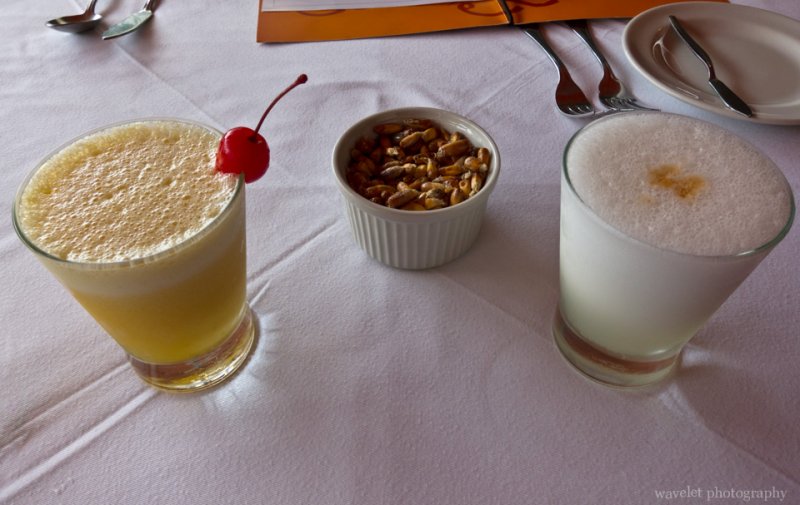
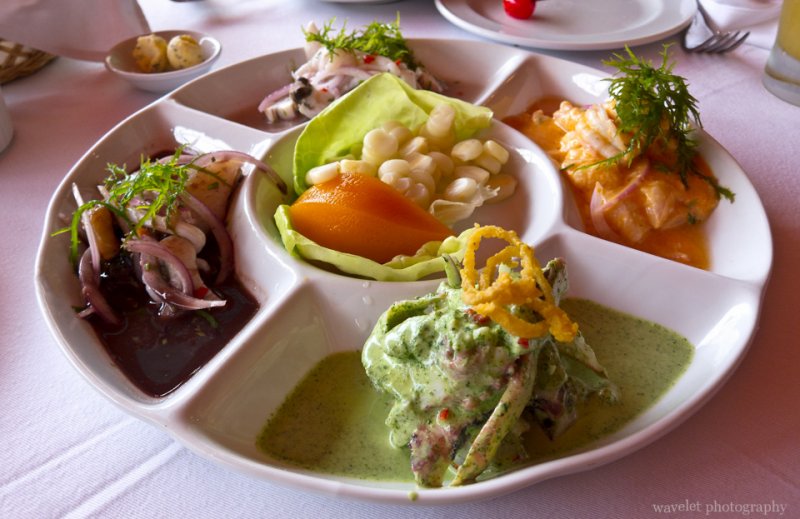
After the big meal, we walked to the Lima’s seaside. Miraflores is Lima’s commercial hub. Most of shops and hotels are located here. It is very tourists friendly. It only took us 10 minutes to walk from our hotel to the park at the clifftops. From here, you can overlook the Pacific Ocean. The park offers activities such as skateboarding and wind gliding.
Walking another 15 minutes along the cliff, we came to Larcomar. It is a shopping mall carved into the cliffs. Consisting many shops and restaurants, this might be the most modern place of Lima city.
Coming back from Larcomar, at about 6pm, it started getting dark. We walked further to Miraflores’ central park, Parque Kennedy. The park is surrounded by restaurants and bars, including Starbuck, MacDonald and Kentucky Chicken. At one side, there is a church called Iglesia de la Virgen Milagrosa. Around it, it is a pedestrian street where artists often set up their easels to show off their works. The park is a popular gathering place for locals, especially at the small amphitheater, which is transformed to a dance arena on every Sunday night.